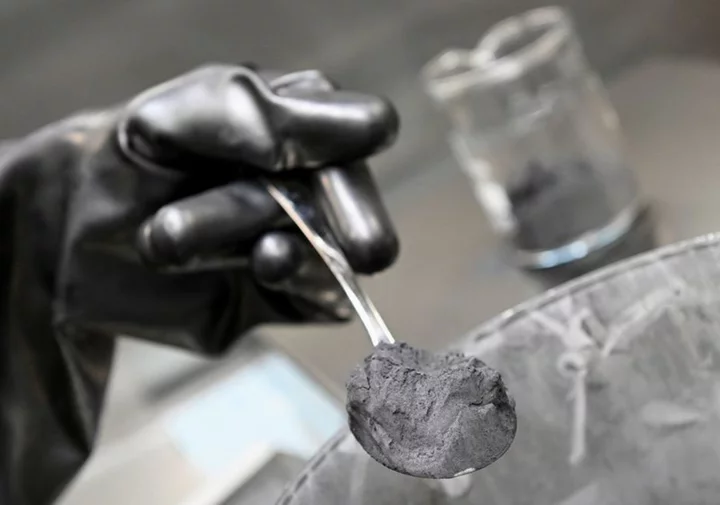By Nick Carey, Akash Sriram and Ernest Scheyder
China's move on Friday to curb exports of graphite, a key electric vehicle battery material, will only accelerate efforts to develop alternative sources and materials, but that will take time, industry executives and analysts said.
China, the world's largest graphite producer and exporter, will require export permits as of Dec. 1 for some graphite products, including spherical graphite used by automakers. It refines more than 90% of the world's graphite into the material used in almost all EV battery anodes, which is the negatively charged portion of a battery.
China's decision may escalate trade disputes globally and spur other countries to prioritize research into alternative sources and materials, industry executives said.
"We see China's move as a potential catalyst to highlight the urgency of improving (U.S.) graphite supply," said John DeMaio, president of Graphex Group's graphene division.
Graphex plans to open a graphite processing facility in Warren, Michigan, by the end of 2024 to supply U.S. automakers with at least 10,000 metric tons per year of the key metal.
Graphex aims to be a refiner in the West, not a miner. It has graphite supply deals with Syrah Resources and is looking for other sources, DeMaio said.
Tesla, which did not respond to a request for comment, has been a leader in securing graphite and signing deals with Syrah and Magnis Energy Technologies.
New investments in the U.S. and Europe aim to challenge China's stranglehold on graphite with a focus on developing synthetic graphite, but industry experts have said the effort will be an uphill battle.
Synthetic graphite could account for nearly two-thirds of the EV battery anode market by 2025, Benchmark Mineral Intelligence estimates.
However, China battery materials giants such as BTR and Shanshan are also investing hundreds of millions of dollars to produce more synthetic graphite.
Vianode, an Oslo-based synthetic graphite startup, is starting small scale production in Norway next year, ramping up to full scale in Europe and the U.S. by 2030 with enough material to supply roughly 2 million EVs.
Chief Operating Officer Hans Erik Vatne told Reuters recently that developing synthetic graphite production is costly, but that is the price to pay to reduce reliance on China.
"Are we as consumers willing to pay more to have that sustainable materials in our batteries?" he said in August. "That's really what we need to hope for because we need a higher price because the capex of building such a plant with this advanced technology is higher."
SILICON SOLUTION?
Another anode ingredient is silicon, which enables an EV to drive longer distances before recharging.
The maximum amount of silicon added to batteries is about 10% because the material expands during use and can degrade the battery. But companies are working to push that share higher.
U.S. startup GDI, for instance, is developing 100% silicon anodes for batteries. GDI CEO Rob Anstey said his company is talking to most automakers about the technology.
"China is decades ahead in graphite and it's too late to try and catch up," he told Reuters on Friday. "We must move to the next level of lithium-ion and EV performance."
"This is our time to wake up and say, okay we need to start working on the next generation of battery and of materials," he added.
The curbs by China also could lower exports and raise prices, just like they did after a similar move in August for two chip-making metals, gallium and germanium.
"This regulation is expected to increase the scarcity of graphite, which in turn raises the cost of power batteries, leading to higher production costs for EVs," Canalys analyst Alvin Liu said.
Many automakers sell EVs at a loss, so higher costs would not be welcome. With rising EV sales, automakers are racing to lock in supplies from outside China, but shortages are looming.
The main use of graphite has been in the steel industry, but EV sales are due to more than triple by 2030 to 35 million from 2022, BMO Capital Markets forecasts.
Each EV on average needs 50 kg to 100 kg (110 pounds to 220 pounds) of graphite in its battery pack for the anodes, about twice the amount of lithium.
Automakers were largely quiet on Friday, studying the decision.
"We don't expect short-term effects on our supply situation, but will watch the issue closely," BMW said in a statement. "We could react quickly and flexibly in our risk management if necessary."
Volvo Cars and Renault said it was too early to comment, but they were following the situation closely.
Mercedes declined to comment, but said in June it was diversifying raw materials sourcing, including graphite. Stellantis and Rivian declined to comment.
Officials with Volkswagen, General Motors, Ford, Lucid and Fisker could not immediately be reached to comment.
(Reporting by Akash Sriram in Bengaluru, Ernest SCheyder in Houston and Nick Carey in London; additional reporting by Christina Amann in Berlin, Marie Mannes in Stockholm, Gilles Guillaume in Paris, Ilona Wissenbach in Frankfurt; writing by Ben Klayman; Editing by Josie Kao)

